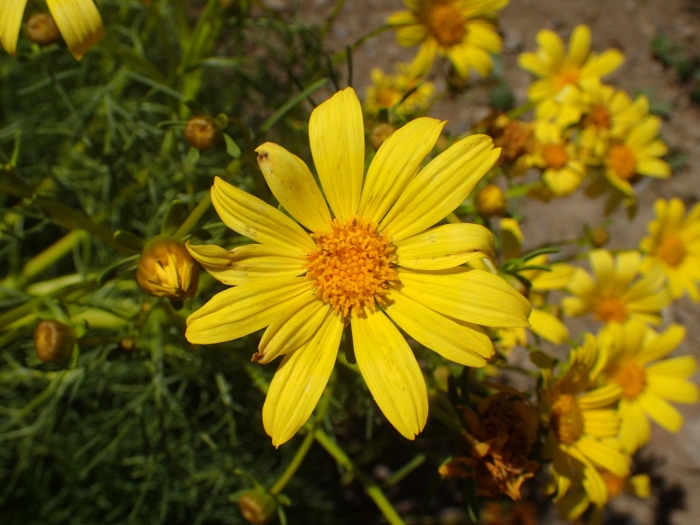Giant Coreopsis
(Coreopsis gigantea)
Giant Coreopsis (Coreopsis gigantea)
/
/

George Williams
CC BY 4.0
Image By:
George Williams
Recorded By:
Copyright:
CC BY 4.0
Copyright Notice:
Photo by: George Williams | License Type: CC BY 4.0 | License URL: http://creativecommons.org/licenses/by/4.0/ | Rights Holder: George Williams | Publisher: iNaturalist | Date Created: 2018-04-17T12:53:27-07:00 |



















































Estimated Native Range
Summary
Coreopsis gigantea, commonly known as Giant Coreopsis, is a deciduous perennial subshrub native to coastal bluffs and dry slopes in Southern California and the Channel Islands. It typically grows up to 4 feet (1.2 m) high and 2 feet (0.61 m) wide, with a thick, woody trunk that can reach up to 1 meter (3.3 ft) tall and 4–10 centimeters (1.6–3.9 in) in diameter. The plant is summer deciduous, leaving a sculptural bare trunk and branches during the dry season. Its bright green leaves and daisy-like yellow flowers, which are 6–20 cm in diameter, appear at the top of the trunk, while the rest of the trunk remains bare. Giant Coreopsis blooms in the spring and early summer, with flowers that are moderately showy.
Giant Coreopsis is valued for its unique appearance, drought tolerance, and ability to thrive in poor soils. It is used in native plant, drought-tolerant, and wildlife gardens, as well as in natural landscaping and habitat restoration projects. The plant requires minimal watering during the summer, good drainage, and is not tolerant of excess moisture. It performs best in full sun, with low amounts of water, and in soils with medium or fast drainage. While it is generally low-maintenance, it can be susceptible to root rot if overwatered or planted in poorly drained soils.CC BY-SA 4.0
Giant Coreopsis is valued for its unique appearance, drought tolerance, and ability to thrive in poor soils. It is used in native plant, drought-tolerant, and wildlife gardens, as well as in natural landscaping and habitat restoration projects. The plant requires minimal watering during the summer, good drainage, and is not tolerant of excess moisture. It performs best in full sun, with low amounts of water, and in soils with medium or fast drainage. While it is generally low-maintenance, it can be susceptible to root rot if overwatered or planted in poorly drained soils.CC BY-SA 4.0
Plant Description
- Plant Type: Shrub
- Height: 1-4 feet
- Width: 1-2 feet
- Growth Rate: Moderate
- Flower Color: Yellow
- Flowering Season: Spring, Winter
- Leaf Retention: Deciduous
Growth Requirements
- Sun: Full Sun
- Water: Low
- Drainage: Fast, Medium
Common Uses
Bee Garden, Bird Garden, Butterfly Garden, Deer Resistant, Drought Tolerant, Groundcover, Hummingbird Garden, Low Maintenance, Rabbit Resistant, Rock Garden, Showy Flowers
Natural Habitat
Coastal bluffs and dry slopes in Southern California and the Channel Islands
Other Names
Common Names:
Scientific Names: Coreopsis gigantea , Leptosyne gigantea , Tuckermannia gigantea
GBIF Accepted Name: Coreopsis gigantea (Kellogg) Hall